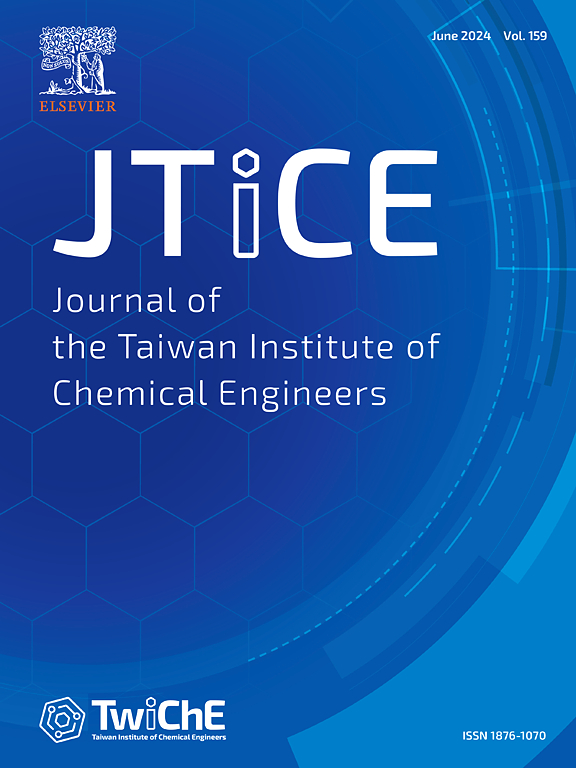基于无水磷石膏的高性能磷石膏渣水泥:力学强化与环境评价
IF 6.3
3区 工程技术
Q1 ENGINEERING, CHEMICAL
Journal of the Taiwan Institute of Chemical Engineers
Pub Date : 2025-06-30
DOI:10.1016/j.jtice.2025.106259
引用次数: 0
摘要
为了解决磷石膏渣水泥(PSC)中由于杂质相关的性能问题导致的低磷石膏利用率的挑战,本研究引入了一种新的方法,即加入煅烧的无水磷石膏(APG)来开发高磷石膏含量的PSC体系。创新之处在于利用电石渣(CCR)和高炉磨渣(GBFS)的协同活化机制,增强APG的低反应性和环境友好性。采用水化热、x射线衍射(XRD)、傅里叶变换红外光谱(FTIR)、热重(TG)、扫描电镜(SEM)和汞侵入孔隙度仪(MIP)等分析了水化过程、微观结构和孔隙结构,并对环境行为进行了评价。结果表明:最佳配合比(APG 58%, GBFS 40%, CCR 2%)可获得较高的APG掺入率(58%),同时具有良好的机械和耐水性,28天抗压强度为76.50 MPa,吸水率为1.71%,软化系数为0.93;ccr诱导的碱度促进了GBFS的解离,生成丰富的C-S-H凝胶和钙矾石,细化了孔隙结构,致密了基质,显著提高了抗水性;加入1% ~ 2%的CCR可提高体系的碱度,有利于水化反应。提高PSC的pH值可以有效地增加重金属和磷的浸出风险。此外,PSC的碳排放量仅为普通硅酸盐水泥的1/7。研究成果可以丰富PSC系统,提高固体废物的利用率。本文章由计算机程序翻译,如有差异,请以英文原文为准。

High-performance phosphogypsum slag cement based on anhydrous phosphogypsum: mechanical enhancement and environmental assessment
To address the challenge of low phosphogypsum (PG) utilization in phosphogypsum slag cement (PSC) due to impurity-related performance issues, this study introduces a novel approach by incorporating calcined anhydrous phosphogypsum (APG) to develop a high-APG-content PSC system. The innovation lies in leveraging a synergistic activation mechanism using calcium carbide residue (CCR) and ground blast furnace slag (GBFS) to enhance the low reactivity and environmental friendliness of APG. The hydration process, microstructure, and pore structure were analyzed by Hydration heat, X-ray diffraction (XRD), Fourier transform infrared spectrum (FTIR), thermogravimetry (TG), scanning electron microscope (SEM), and mercury intrusion porosimeter (MIP), and the environmental behavior was evaluated. Results showed that: An optimized mix proportion (58 % APG, 40 % GBFS, 2 % CCR) that achieved high APG incorporation (58 %) while providing excellent mechanical and water resistance, with 28-day compressive strength of 76.50 MPa, 1.71 % water absorption, and a 0.93 softening coefficient; CCR-induced alkalinity promoted GBFS dissociation, generating abundant C-S-H gel and ettringite to refine pore structure and densify the matrix, significantly improving water resistance; Adding 1 %-2 % CCR increased the alkalinity of the system, which was beneficial for hydration reaction. Improving the pH value of PSC effectively increases the leaching risk of heavy metals and phosphorus. Moreover, the carbon emissions of PSC were <1/7 of ordinary Portland cement. The research results can enrich the PSC system and improve the utilization rate of solid waste.
求助全文
通过发布文献求助,成功后即可免费获取论文全文。
去求助
来源期刊
CiteScore
9.10
自引率
14.00%
发文量
362
审稿时长
35 days
期刊介绍:
Journal of the Taiwan Institute of Chemical Engineers (formerly known as Journal of the Chinese Institute of Chemical Engineers) publishes original works, from fundamental principles to practical applications, in the broad field of chemical engineering with special focus on three aspects: Chemical and Biomolecular Science and Technology, Energy and Environmental Science and Technology, and Materials Science and Technology. Authors should choose for their manuscript an appropriate aspect section and a few related classifications when submitting to the journal online.

 求助内容:
求助内容: 应助结果提醒方式:
应助结果提醒方式:


